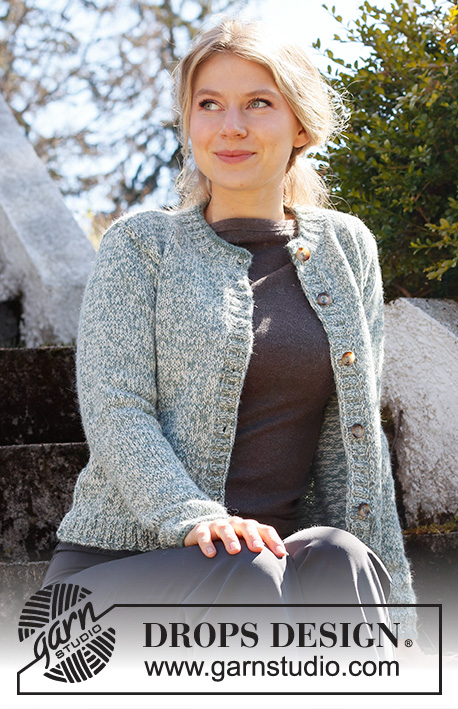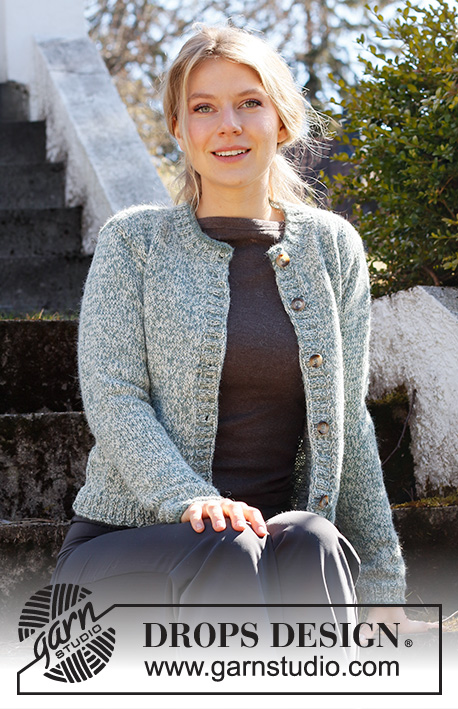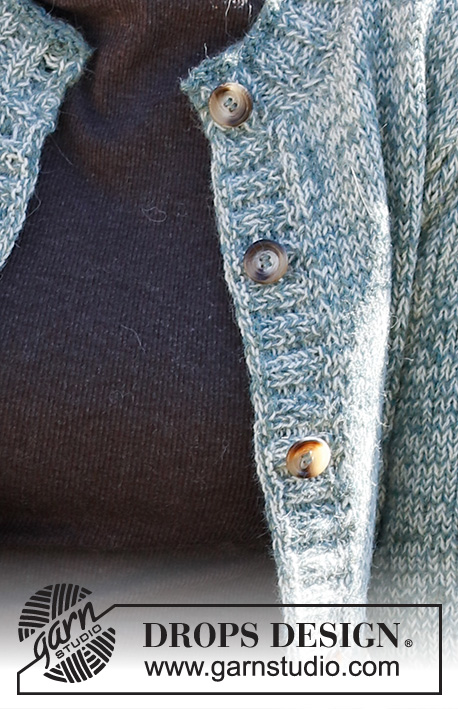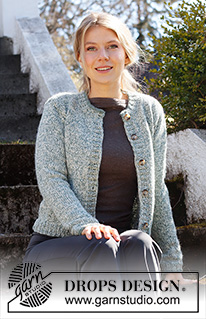Mists of Dover Jacket |
|
 |
 |
Knitted jacket in 2 strands DROPS Alpaca. Size: S - XXXL
DROPS 215-32 |
|
|
------------------------------------------------------- EXPLANATION FOR THE PATTERN: ------------------------------------------------------- GARTER STITCH (back and forth): Knit all rows. 1 ridge vertically = knit 2 rows. DECREASE TIP (evenly): To calculate how to decrease evenly, use the total number of stitches on row (e.g. 96 stitches), and divide stitches by number of decreases to be done (e.g. 16) = 6. In this example decrease by knitting every 5th and 6th stitch together. INCREASE TIP (applies to sleeves): Increase by making 1 yarn over inside 1 edge stitch, on next row work yarn over twisted to avoid holes. ------------------------------------------------------- START THE PIECE HERE: ------------------------------------------------------- JACKET - SHORT OVERVIEW OF THE PIECE: Work front pieces and back piece back and forth on circular needle separately. Then work bands on front pieces. Work sleeves back and forth on circular needle. Work neck edge back and forth at the end. BACK PIECE: Work piece back and forth on circular needle. Cast on 96-104-112-120-132-144 stitches (including 1 edge stitch in each side) on circular needle size 4 mm with 1 strand off white and 1 strand sea fog. Knit 1 row from right side and knit 1 row from wrong side. Continue with rib as follows (1st row = right side): 1 edge stitch in GARTER STITCH - read explanation above, * purl 2, knit 2 *, work from *-* until 3 stitches remain, finish with purl 2 and 1 edge stitch in garter stitch. When rib measures 4 cm, switch to circular needle size 5 mm. Continue in stocking stitch and edge stitches as before – AT THE SAME TIME on 1st row decrease 16-18-18-18-22-24 stitches evenly - read DECREASE TIP in explanation above = 80-86-94-102-110-120 stitches. REMEMBER THE KNITTING TENSION! When piece measures 10 cm, decrease 1 stitch inside 1 edge stitch in each side. Repeat decrease every 5 cm 4 times in total = 72-78-86-94-102-112 stitches. When piece measures 31-32-33-34-35-36 cm, cast off for armhole at beginning of every row in each side: 3 stitches 1-1-1-1-2-2 times, 2 stitches 0-0-1-3-3-4 times and 1 stitch 1-3-4-3-3-5 times = 64-66-68-70-72-74 stitches. When piece measures 48-50-52-54-56-58 cm, cast off the middle 26-26-26-28-28-28 stitches for neck. Finish each shoulder separately. Then decrease 1 stitch on next row from neck =18-19-20-20-21-22 stitches on shoulder. Cast off when piece measures 50-52-54-56-58-60 cm. Work the other shoulder the same way. LEFT FRONT PIECE: Work piece back and forth on circular needle. Cast on 48-52-56-60-64-72 stitches (including 1 edge stitch in each side) on circular needle size 4 mm with 1 strand off white and 1 strand sea fog. Knit 1 row from right side and knit 1 row from wrong side. Continue in rib as follows: 1 edge stitch in garter stitch, * knit 2, purl 2 *, work from *-* until 3 stitches remain, knit 2 and 1 edge stitch in garter stitch. When rib measures 4 cm, switch to circular needle size 5 mm. Continue in stocking stitch and edge stitches as before – AT THE SAME TIME on 1st row decrease 8-9-9-9-9-12 stitches evenly = 40-43-47-51-55-60 stitches. When piece measures 10 cm, begin decrease in the side as on back piece - decrease inside 1 edge stitch at the beginning of row from right side. After all decreases are done, 36-39-43-47-51-56 stitches remain on needle. When piece measures 31-32-33-34-35-36 cm, begin decrease in the side for armholes as on back piece - decrease inside 1 edge stitch at the beginning of row from right side. After all decreases are done, 32-33-34-35-36-37 stitches remain on needle. When piece measures 42-44-46-48-50-52 cm, cast off for neck at beginning of every row from wrong side: 8-8-8-9-9-9 stitches 1 time, 2 stitches 1 time and then 1 stitch 4 times = 18-19-20-20-21-22 stitches on shoulder. Cast off when piece measures 50-52-54-56-58-60 cm. LEFT BAND: Pick up (from right side) approx. 70 to 90 stitches with 1 strand off white and 1 strand sea fog on circular size 4 mm inside 1 edge stitch along left front piece. Knit 1 row from wrong side while at the same time increasing evenly to: 87-91-95-99-103-107 stitches(number of stitches must be divisible by 4 + 3). Then work as follows from right side (from the top): 1 edge stitch which is knitted on all rows, * knit 2, purl 2 *, work from *-* until 6 stitches remain, finish with knit 2 and 4 stitches in garter stitch. Continue with knit over knit, purl over purl and garter stitch over garter stitch until band measures approx. 3½ cm (adjust so that next row is from wrong side). Now knit 1 row from wrong side, then cast off by knitting from right side. RIGHT FRONT PIECE: Work piece back and forth on circular needle. Cast on 48-52-56-60-64-72 stitches (including 1 edge stitch in each side) on circular needle size 4 mm with 1 strand off white and 1 strand sea fog. Knit 1 row from right side and knit 1 row from wrong side. Continue in rib as follows: 1 edge stitch in garter stitch, * knit 2, purl 2 *, work from *-* until 3 stitches remain, knit 2 and 1 edge stitch in garter stitch. When rib measures 4 cm, switch to circular needle size 5 mm. Continue in stocking stitch and edge stitches as before – AT THE SAME TIME on 1st row decrease 8-9-9-9-9-12 stitches evenly = 40-43-47-51-55-60 stitches. When piece measures 10 cm, begin decrease in the side as on back piece - decrease inside 1 edge stitch at the beginning of row from wrong side. After all decreases are done, 36-39-43-47-51-56 stitches remain on needle. When piece measures 31-32-33-34-35-36 cm, begin decrease in the side for armholes as on back piece - decrease inside 1 edge stitch at the beginning of row from wrong side. After all decreases are done, 32-33-34-35-36-37 stitches remain on needle. When piece measures 42-44-46-48-50-52 cm, cast off for neck at beginning of every row from right side: 8-8-8-9-9-9 stitches 1 time, 2 stitches 1 time and then 1 stitch 4 times = 18-19-20-20-21-22 stitches on shoulder. Cast off when piece measures 50-52-54-56-58-60 cm. RIGHT BAND: Pick up (from right side) approx. 70 to 90 stitches with 1 strand off white and 1 strand sea fog on circular size 4 mm inside 1 edge stitch along right front piece. Knit 1 row from wrong side while at the same time increasing evenly to: 87-91-95-99-103-107 stitches(number of stitches must be divisible by 4 + 3). Then work as follows from right side (from the bottom): 4 stitches in garter stitch, * knit 2, purl 2 *, repeat from *-* until 3 stitches remain, finish with knit 2 and 1 stitch in garter stitch. Continue with knit over knit, purl over purl and garter stitch over garter stitch until band measures approx. 2 cm (adjust so that next row is from right side). Now make buttonholes along the band, top buttonhole on jacket is made when neck edge is worked - therefore begin by placing marker where the remaining holes should be. Bottom buttonhole should be approx. 3-2½-2-4-3-2 cm from edge at the bottom and top hole should be approx. 7-7½-8-8-7-7½ cm from the edge and up. Then place the remaining 3-3-3-3-4-4 buttonholes on band, approx. 8-8½-9-9½-8-8½ cm apart. Decrease for 1 buttonhole as follows: Work 2 stitches together and make 1 yarn over, knit or purl yarn over into pattern on next row. Work until band measures approx. 3½ cm, knit 1 row from wrong side and cast off by knitting from right side. SLEEVE: Work piece back and forth on circular needle. Cast on 42-46-46-50-50-50 stitches (including 1 edge stitch in garter stitch in each side) on circular needle size 4 mm with 2 strands sea fog. Knit 1 row from right side and knit 1 row from wrong side. Switch to 1 strand off white and 1 strand sea fog. Work rib with knit 2/purl 2 with 1 edge stitch in garter stitch in each side. When rib measures 4 cm, switch to circular needle size 5 mm. Work in stocking stitch with 1 edge stitch in garter stitch – AT THE SAME TIME on 1st row decrease 4-6-4-6-4-4 stitches evenly = 38-40-42-44-46-46 stitches. When piece measures 12-12-12-12-11-11 cm increase 1 stitch inside edge stitch in each side - read INCREASE TIP in explanation above. Repeat increase every 3½-3-3-2½-2½-2 cm a total of 11-12-12-13-14-16 times = 60-64-66-70-74-78 stitches. When piece measures 50-49-48-47-46-44 cm (shorter measurements in the larger sizes because of longer sleeve cap and wider shoulders), cast off for sleeve cap at beginning of every row in each side: 3 stitches 1 time, 2 stitches 3 times, 1 stitch 0-1-2-3-4-5 times and then 2 stitches in each side until piece measures 55 cm. Now cast off 3 stitches 1 time in each side. Cast off the remaining stitches, piece measures approx. 56 cm in all sizes. Work the other sleeve the same way. ASSEMBLY: Sew shoulder seams edge to edge. NECK EDGE: Use circular needle size 4 mm and 1 strand off white and 1 strand sea fog, begin from right side and pick up approx. 82-90 stitches around the neck (also over bands on each front piece), number of stitches must be divisible by 4 + 2. Work as follows from wrong side: 1 edge stitch in garter stitch, purl 1, * knit 2, purl 2 *, work from *-* until 4 stitches remain, knit 2, purl 1 and 1 edge stitch in garter stitch. On next row from right side make the last buttonhole, make a line over where the other buttonholes were decreased on band while AT THE SAME TIME working as follows: Work 1 edge stitch in garter stitch, knit 1, * purl 2, knit 2 *, repeat from *-* until 4 stitches remain, purl 2, knit 1 and 1 edge stitch in garter stitch. Continue rib like this until neck edge measures approx. 3 cm - adjust so that next row is worked from wrong side, switch to 2 strand sea fog and knit 1 row from wrong side. Loosely cast off by knitting on next row. ASSEMBLY: Sew in sleeves. Sew seam under sleeves and seam down along the sides in one inside 1 edge stitch. Sew the buttons on to the left band. |
|

|
|
|
Have you made this or any other of our designs? Tag your pictures in social media with #dropsdesign so we can see them! Do you need help with this pattern?You'll find tutorial videos, a Comments/Questions area and more by visiting the pattern on garnstudio.com. © 1982-2024 DROPS Design A/S. We reserve all rights. This document, including all its sub-sections, has copyrights. Read more about what you can do with our patterns at the bottom of each pattern on our site. |
|





























































Comments / Questions (9)
Hallo, ist bei den Maßen für den Halskragen, die Reihen aus Rippenmuster erhalten oder muss man diese aus den Maßen bei der Herstellung auf Papier noch abziehen. Ich hoffe, meine Frage war verständlich. Viele Grüße Myriam Gateault
11.04.2024 - 08:19Guten Tag, ich stricke die Jacke. Das Rückenteil ist fertig. Beim 1. Vorderteil weiß ich nicht weiter. Nach 10 cm soll ich die Abnahmen machen wie am Rückenteil. Heißt das dass ich an beiden Seiten alle 5 cm abnehmen soll? Dann hätte das Vorderteil doch vorne jeweils keinen geraden Abschluss. Ist das so gewollt? Erst nach Ihrer Antwort stricke ich weiter weil Aufribbeln bei 2 Fäden nicht so toll ist. Danke im Voraus für eine Antwort.
04.04.2024 - 11:50DROPS Design answered:
Liebe Frau Eitel, beim Vorderteilen werden Sie nur an einer Seite abnehmen, die Seite, die zum Rückenteil angenäht wird, so beim linken Vorderteil am Anfang einer Hinreihe und beim rechten Vorderteil am Ende einer Hinreihe. Viel Spaß beim Stricken!
04.04.2024 - 12:55Hoe kan het dat de pas bijna 36 cm meet terwijl ik een pen dunner heb gebruikt(4) en precies het patroon heb gevolgd? Erg mooi patroon trouwens.
12.06.2023 - 13:22DROPS Design answered:
Dag Marja,
Komt de stekenverhouding overeen met die van het patroon? Als dat klopt, zo je geen afwijkende maten horen te krijgen. Welke maat brei je? En bedoel je de breedte van de pas op het achterpand nadat je geminderd hebt voor de armsgaten?
14.06.2023 - 17:55Når der står “når arbejdet måler 10 cm” under bagstykke, er det så 10 cm med eller uden ribkant?
26.01.2022 - 13:15Kan bulen( bagstykket og de 2 forstykker) strikkes på en rundpind indtil ærmegabet, i så fald skal kantmaskerne da trækkes fra
29.10.2021 - 08:37Schade, dass die ersten 3 Fotos nahezu identisch sind. Man kann nicht sehen, wie die Jacke im Stehen am Körper sitzt und wo sich der untere Knopf bzw. das Knopfloch befindet. Nun meine Frage: Setzt man das unterste Knopfloch in die 4 kraus rechte Maschen oder direkt danach und strickt die ersten 2 rechten Maschen zusammen und arbeitet dann einen Umschlag ein? Werden die Knopflöcher alle so gearbeitet, dass die bei den Rippen immer die 2 rechten Maschen zusammengestrickt werden + 1 Umschlag?
01.02.2021 - 21:56DROPS Design answered:
Liebe Jenny, am besten vergleichen Sie die Maßen einer ähnliche Jacke, die Sie gerne haben, mit den in der Skizze, so finden Sie die richtige passende Größe - hier lesen Sie mehr. Das unterste Knopfloch wird ca 3-2½-2-4-3-2 cm über den unteren Rand sein - siehe RECHTE BLENDE - gerne können Sie die Knopflöcher je nach der linke Blende anpassen. Viel Spaß beims tricken!
02.02.2021 - 10:12Bonjour, ce modèle peut-il se tricoter avec un seul fil et dans ce cas les mesures sont-elles les mêmes et quel numéro d'aiguilles utiliser svp ? cordialement
21.12.2020 - 21:25DROPS Design answered:
Bonjour Mme Langen, ce modèle peut tout à fait se tricoter avec un seul fil du groupe C qui remplacera 2 fils du groupe A (= Alpaca ici en l'occurence), mais, pour conserver les explications du modèles, vous devez conserver la même tension/le même échantillon - vous trouverez plus d'infos ici. Si vous souhaitez utiliser une tension différente, il vous faudra chercher un modèle correspondant à l'échantillon souhaité - en utilisant le filtre "échantillon" ici. Bon tricot!
22.12.2020 - 09:44BONJOUR Pourriez-vous me conseiller ? Quel coloris puis-je utiliser avec le Pétrole Mix 7240 en alpaca pour que cela soit harmonieux ? Merci beaucoup de votre réponse.
15.11.2020 - 12:05DROPS Design answered:
Bonjour Mme Lasalle, pour toute assistance au choix des couleurs, merci de bien vouloir contacter directement votre magasin DROPS, même par mail ou téléphone, il est plus à même de vous aider en fonction de ce que vous recherchez. Bon tricot!
16.11.2020 - 08:53Suerschöne schlichte Jacke in tollen Winterfarben... Gefällt mir sehr gut!
24.09.2020 - 07:34